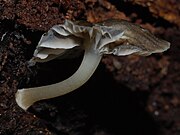|
Cuphophyllus
Cuphophyllus is a genus of agaric fungi in the family Hygrophoraceae. Cuphophyllus species belong to a group known as waxcaps in English, sometimes also waxy caps in North America or waxgills in New Zealand. In Europe, Cuphophyllus species are typical of waxcap grasslands, a declining habitat due to changing agricultural practices. As a result, four species, Cuphophyllus atlanticus (as C. canescens),[1] C. colemannianus, C. lacmus, and C. lepidopus are of global conservation concern and are listed as "vulnerable" on the IUCN Red List of Threatened Species.[2]
TaxonomyHistoryThe genus was described by French mycologist Marcel Bon in 1985,[3] though it was subsequently synonymized with Hygrocybe by some authorities.[4] Cuphophyllus species have sometimes been referred to the genus Camarophyllus (Fr.) P.Kumm., but, as argued by Donk (1962), the type species of Camarophyllus must be Agaricus camarophyllus Alb. & Schwein. the species from which the genus takes its name.[5] This means that Camarophyllus sensu stricto is a synonym of Hygrophorus, since A. camarophyllus is a Hygrophorus species (Hygrophorus camarophyllus). This is now accepted by all standard authorities.[6][7][4] Singer (1951), however, proposed Agaricus pratensis (= Cuphophyllus pratensis) as the type species of Camarophyllus,[8] which means that Camarophyllus sensu Singer is a synonym of Cuphophyllus. Current statusRecent molecular research, based on cladistic analysis of DNA sequences, indicates that Cuphophyllus is monophyletic and forms a natural group distinct from Hygrocybe sensu stricto.[9][10][11] DescriptionSpecies are distinguished from most other waxcaps by producing non-viscid, typically white, grey, or brownish basidiocarps (fruit bodies) often with decurrent lamellae (gills). Species of the genus Chromosera are superficially similar, though often more brightly coloured.[4] Habitat and distributionIn Europe, Cuphophyllus species are typically found in agriculturally unimproved, short-sward grasslands (including pastures and lawns). Elsewhere, they are most frequently found in woodland. The genus is cosmopolitan.[4] Economic usageFruit bodies of one of the commoner European waxcap species, C. pratensis, are edible[4] and widely collected, sometimes being offered for sale in local markets. SpeciesThe following species are recognised in the genus Cuphophyllus:[12]
See alsoReferences
|
||||||||||||||||||||||||||





